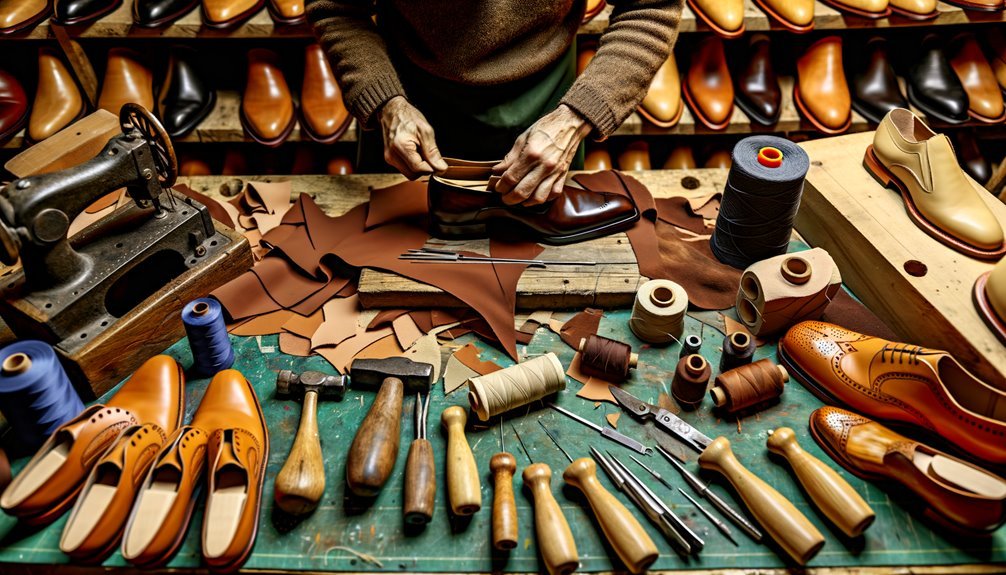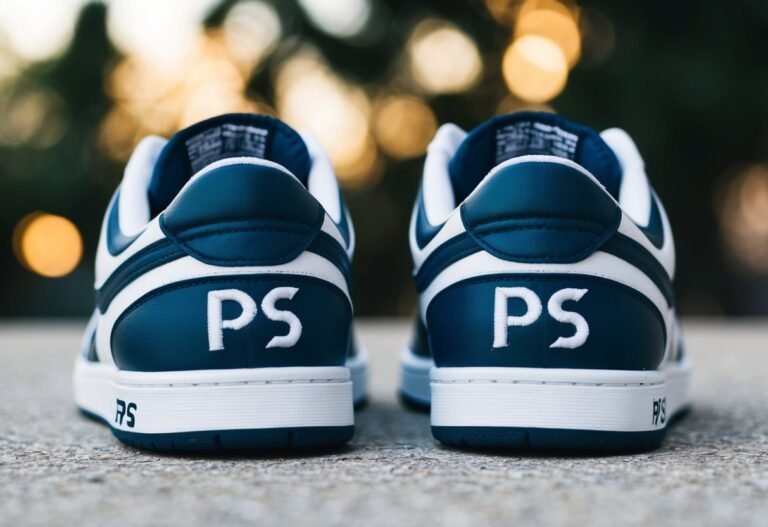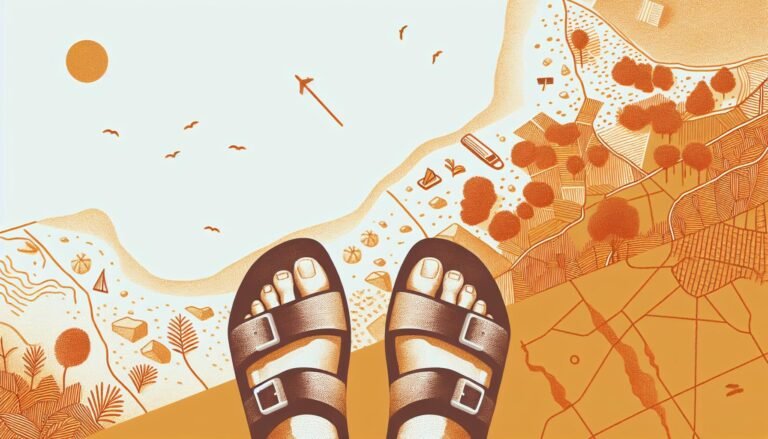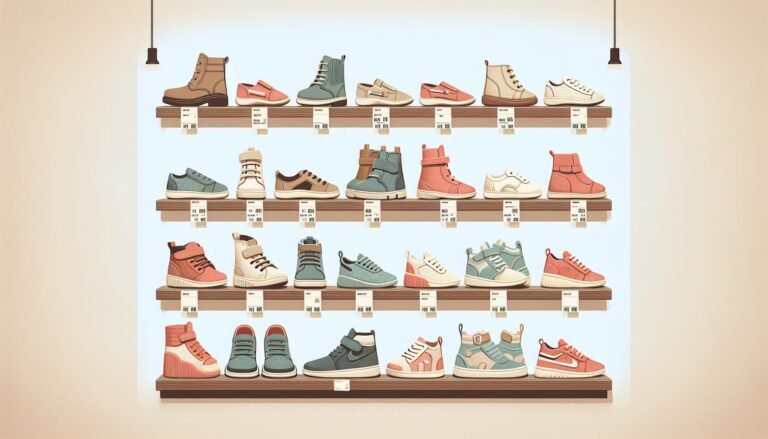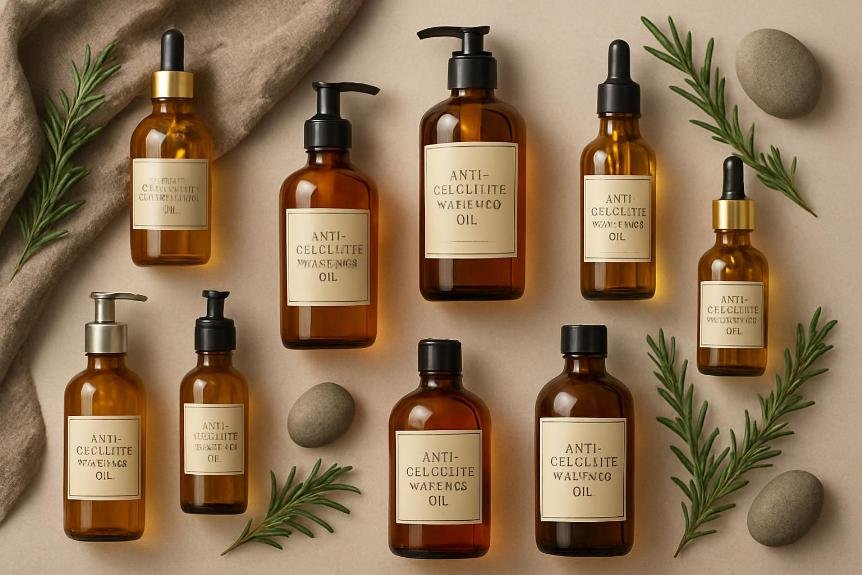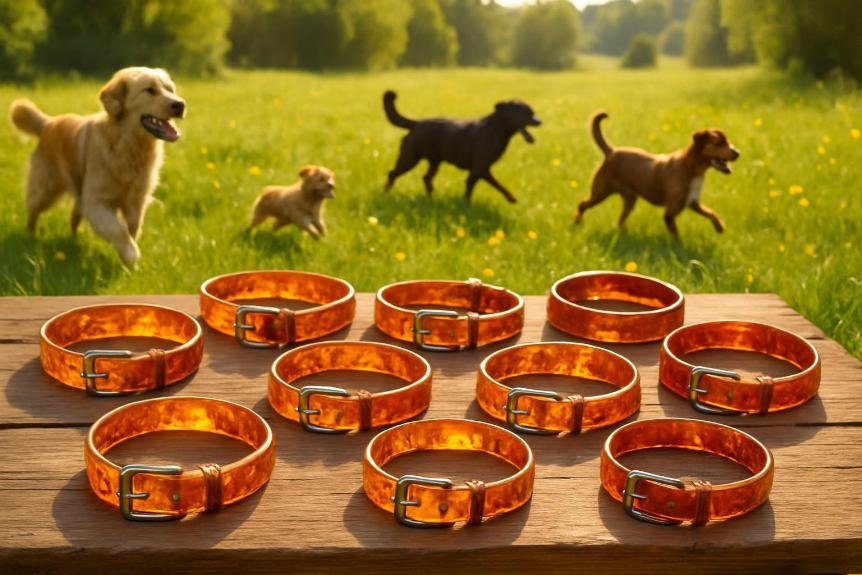7 Key Steps in Crafting Quality Shoes
Crafting quality shoes involves seven key steps guaranteeing perfect fit and elegance. Begin with precise measurements to select your style, followed by meticulous shoe last making to replicate foot contours. Next, pattern cutting and clicking guarantee component integration. Assemble the shoe with precise stitching, and test the trial shoe for fit. Final craftsmanship elevates shoes to luxury standards. A thorough quality check assures durability. Each step reflects detailed artistry and there’s so much more to uncover.
Key Takeaways
- Capture precise foot measurements for a perfect fit and comfort.
- Develop accurate shoe lasts to replicate foot contours and test fit.
- Create precise paper patterns for seamless integration of shoe components.
- Assemble shoes with quality materials ensuring durability and designer’s vision.
- Conduct thorough craftsmanship and quality checks to meet luxury standards.
Measurements & Selection of Style

When crafting bespoke shoes, the journey begins with taking precise measurements to guarantee a perfect fit and selecting a style that reflects personal taste. You’ll experience the intricate process where a Master Last-Maker captures every aspect of your feet, including length, width, and arch height. These measurements are essential in crafting an accurate shoe last, which serves as the foundation for your custom shoes.
Your input is significant in choosing not just the shoe design but also the quality leather and other materials that align with your preferences. Every detail is meticulously considered, ensuring that the shoe design complements your personal style. This attention to detail results in a pair of bespoke shoes that perfectly blend comfort and elegance, with a fit that feels uniquely yours.
Shoe Last Making
In crafting accurate shoe lasts, you’re shaping the foundation for both comfort and style. By selecting materials like wood or plastic, you can meticulously replicate the foot’s unique contours, ensuring each pair of shoes fits perfectly. Consider factors such as foot movement and heel height to create lasts that not only enhance comfort but also preserve the shoe’s design integrity.
Crafting Accurate Shoe Lasts
Although often overlooked, crafting accurate shoe lasts is a cornerstone in the art of shoemaking, essential for achieving both comfort and precision in footwear design. The last, a critical mold in shoe manufacturing, guarantees an accurate fit, marrying the science of foot anatomy with the elegance of shoe design. Skilled artisans craft lasts from materials like wood or plastic, meticulously shaping them for both left and right shoes. This bespoke fit process accounts for:
- Unique foot movement and heel height
- Individual anatomical measurements
- The integrity and aesthetics of the shoe’s design
- Maintaining the shoe’s shape post-construction
A well-crafted last isn’t just a tool; it’s the soul of the shoe, where precision meets artistry, transforming raw materials into graceful, functional footwear.
Lasts for Perfect Fit
Crafting accurate shoe lasts sets the stage for creating footwear that’s not only visually appealing but also impeccably comfortable. In the shoemaking process, a last is more than just a mold; it’s the foundation of perfect fit and timeless aesthetic. Made from wood or plastic, these lasts are tailored for each shoe, respecting foot movement and heel height nuances. By using precise measurements, including advanced scans and pictures, you guarantee the shoe design aligns perfectly with the client’s foot.
| Last Material | Purpose | Benefits |
|---|---|---|
| Wood | Traditional | Durable, customizable |
| Plastic | Modern | Lightweight, precise |
| Composite | Hybrid Use | Versatile, strong |
These well-crafted lasts not only guide the upper’s shape during construction but validate the final shoe’s design, confirming it embodies your vision.
Pattern Cutting & Clicking
Before the beauty of a finished shoe captivates, the intricate process of pattern cutting and clicking lays the groundwork for its creation. As a skilled artisan, you begin with creating a paper pattern that mirrors the shoe last’s precise measurements. Each component—vamp, cap, tongue, and quarters—must flawlessly integrate into the shoe upper. With unyielding precision, you assess the leather’s quality, considering its weight and pliability, guaranteeing your cuts uphold the highest standards of quality control. Your expertise transforms the designer’s vision into tangible components, ready for the next phase.
- Meticulous assessments guarantee leather excellence
- Precision cuts prevent fit and aesthetic issues
- Skilled artistry crafts the shoe’s foundational elements
- Quality control maintains the designer’s vision
Assembling the Shoe
When assembling the shoe, you’ll start by expertly stitching the upper components, ensuring each seam aligns perfectly for both durability and design precision. Whether using hand-stitching or a sewing machine, your focus on secure seams is paramount before moving to securely attach the soles, which anchors the shoe’s overall integrity. Finally, apply the finishing touches with an artisan’s eye to enhance both the aesthetic and functional qualities of the shoe, ensuring a product that meets the highest standards of quality.
Stitching Upper Components
Diving into the intricate process of stitching upper components, you’ll find that precision and skill are essential. As you carefully sew together cut leather pieces, using high-quality threads guarantees durability and a precise fit. Whether through hand-stitching or machine sewing, the choice reflects the desired quality and craftsmanship of the final product. Alignment is vital; any misstep can compromise both fit and appearance, diminishing the shoe’s overall quality. Skilled artisans employ specific techniques to shape the upper, requiring a steady hand and attention to detail for a professional finish. Properly secured seams lay the groundwork for future steps, enhancing longevity and structural integrity.
- Feel the pride in crafting with precision.
- Witness the transformation of leather.
- Experience the satisfaction of perfect alignment.
- Embrace the art of meticulous craftsmanship.
Attaching Soles Securely
Having meticulously stitched the upper components, the next step is to secure the sole, a task that marries the shoe’s foundation with its crafted exterior. Selecting the appropriate sole material is critical for aligning with the shoe design, ensuring ideal traction and comfort. You’ll need to employ both adhesive and stitching techniques to attach the soles securely. This dual approach not only enhances durability but also prepares the shoe for future sole replacements, particularly with methods like Goodyear welting. It’s essential that the sole aligns perfectly with the upper, maintaining the shoe’s aesthetic and structural integrity. Finalizing the shoe’s base through a secure attachment is imperative, as it underpins the shoe’s overall stability and performance, completing this meticulous craftsmanship process.
Finishing Touches Application
As the final phase of crafting quality shoes begins, meticulous attention to detail transforms each pair into a masterpiece. The finishing touches are essential, as each shoe undergoes rigorous quality control to guarantee every component meets the highest standards. Leather surfaces are cleaned and polished, enhancing their appearance and protecting them from wear. This careful treatment not only extends the shoe’s life but also boosts its visual allure. Skilled craftsmen add decorative elements, infusing a personalized touch that elevates the design. Each pair is signed by the cobblers, a mark of their pride in craftsmanship. Finally, the shoes are prepared for boxing, ensuring they’re presented professionally to customers, ready to impress.
The Trial Shoe

When starting the creation of a bespoke shoe, the trial shoe stands as an essential intermediary step that guarantees the final product meets exceptional standards of fit and comfort. Crafted to mirror the final design, albeit without final touches, it allows you to focus on functionality and fit. Precise measurements and client specifications inform this prototype, providing insight into necessary adjustments for bespoke shoemaking. Identifying potential fit issues, the trial shoe confirms a unique fit, tailored to the client’s foot anatomy.
| Aspect | Importance | Details |
|---|---|---|
| Prototype | Essential | Tests fit and comfort |
| Materials | Similar to final | Focus on functionality |
| Measurements | Critical | Client-specific insights |
| Adjustments | Precise | Confirms design accuracy |
| Unique Fit | Tailored | Bespoke shoemaking process |
This meticulous step is pivotal in achieving bespoke excellence.
Final Craftsmanship
With the trial shoe’s insights in hand, the journey progresses to the domain of final craftsmanship, where the shoe’s transformation from prototype to polished art begins. Here, the master craftsman adds stiffeners and meticulously shapes the insole, ensuring ideal support and comfort. Various constructions like Goodyear and Blake enhance the shoe’s durability, with the Goodyear welt allowing future sole replacement. Attention to detail is paramount as the finisher removes the last, polishes the leather, and elevates the shoe to luxury standards.
The master craftsman transforms each shoe from a prototype to polished art, ensuring luxury and durability.
- Feel the care in each stitch
- Admire the sheen from polishing the leather
- Experience unmatched durability
- Relish the ideal support with each step
These elements seamlessly intertwine, ensuring each shoe meets the highest craftsmanship standards.
Quality Check & Finishing Touches
Though the shoe’s journey is nearing its end, the meticulous process of quality check and finishing touches guarantees it truly embodies luxury craftsmanship. Your role in quality control is pivotal, as each shoe undergoes a thorough inspection to identify any defects, confirming it meets the highest luxury standards. The finishing process involves expertly polishing the leather, enhancing its shine, and applying protective coatings to bolster durability. Craftsmen may add unique signatures or decorative elements, emphasizing the shoe’s handcrafted essence. During the final inspection, you’ll meticulously clean the shoes, verify alignment and aesthetic consistency, and confirm all components are securely attached. Finally, shoes are prepared for boxing, reflecting the exquisite craftsmanship through careful presentation and attention to detail.
Frequently Asked Questions
What Are the Steps in the Shoe Manufacturing Process?
You’ll start with selecting quality shoe materials. Employ manufacturing techniques and design innovation, ensuring sustainability practices align with market trends. Focus on consumer preferences, emphasizing detailed craftsmanship. Each step reflects artisan focus and dedication to excellence.
What Are 5 Things Considered in the Design of a Shoe?
When crafting shoes, you embody artistry through material selection, design aesthetics, and comfort features. Consider your target market and manufacturing techniques, embracing sustainability practices. Each choice echoes a promise of quality and purpose, tailored for discerning wearers.
How Do You Perform Quality Control in Shoe Making?
You perform quality control in shoemaking by employing quality assurance techniques like shoe material inspection, production line monitoring, and defect detection methods. Testing durability standards and final product evaluation also guarantee each shoe meets the highest craftsmanship standards.
What Are the Steps Involved in Making a Pair of Shoes?
Ever wondered how shoe materials transform into stunning footwear? By analyzing market trends, using artisan techniques, incorporating comfort features, and adopting sustainability practices, you guarantee each step reflects detailed craftsmanship, creating shoes that balance tradition with modern demands.

